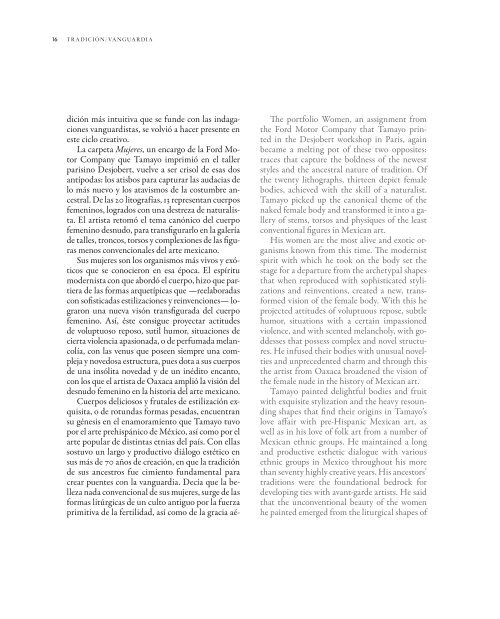TAMAYO - TRADICIÓN:VANGUARDIA
You also want an ePaper? Increase the reach of your titles
YUMPU automatically turns print PDFs into web optimized ePapers that Google loves.
16<br />
TRADICIÓN/<strong>VANGUARDIA</strong><br />
dición más intuitiva que se funde con las indagaciones<br />
vanguardistas, se volvió a hacer presente en<br />
este ciclo creativo.<br />
La carpeta Mujeres, un encargo de la Ford Motor<br />
Company que Tamayo imprimió en el taller<br />
parisino Desjobert, vuelve a ser crisol de esas dos<br />
antípodas: los atisbos para capturar las audacias de<br />
lo más nuevo y los atavismos de la costumbre ancestral.<br />
De las 20 litografías, 13 representan cuerpos<br />
femeninos, logrados con una destreza de naturalista.<br />
El artista retomó el tema canónico del cuerpo<br />
femenino desnudo, para transfigurarlo en la galería<br />
de talles, troncos, torsos y complexiones de las figuras<br />
menos convencionales del arte mexicano.<br />
Sus mujeres son los organismos más vivos y exóticos<br />
que se conocieron en esa época. El espíritu<br />
modernista con que abordó el cuerpo, hizo que partiera<br />
de las formas arquetípicas que —reelaboradas<br />
con sofisticadas estilizaciones y reinvenciones— lograron<br />
una nueva visón transfigurada del cuerpo<br />
femenino. Así, éste consigue proyectar actitudes<br />
de voluptuoso reposo, sutil humor, situaciones de<br />
cierta violencia apasionada, o de perfumada melancolía,<br />
con las venus que poseen siempre una compleja<br />
y novedosa estructura, pues dota a sus cuerpos<br />
de una insólita novedad y de un inédito encanto,<br />
con los que el artista de Oaxaca amplió la visión del<br />
desnudo femenino en la historia del arte mexicano.<br />
Cuerpos deliciosos y frutales de estilización exquisita,<br />
o de rotundas formas pesadas, encuentran<br />
su génesis en el enamoramiento que Tamayo tuvo<br />
por el arte prehispánico de México, así como por el<br />
arte popular de distintas etnias del país. Con ellas<br />
sostuvo un largo y productivo diálogo estético en<br />
sus más de 70 años de creación, en que la tradición<br />
de sus ancestros fue cimiento fundamental para<br />
crear puentes con la vanguardia. Decía que la belleza<br />
nada convencional de sus mujeres, surge de las<br />
formas litúrgicas de un culto antiguo por la fuerza<br />
primitiva de la fertilidad, así como de la gracia aé-<br />
The portfolio Women, an assignment from<br />
the Ford Motor Company that Tamayo printed<br />
in the Desjobert workshop in Paris, again<br />
became a melting pot of these two opposites:<br />
traces that capture the boldness of the newest<br />
styles and the ancestral nature of tradition. Of<br />
the twenty lithographs, thirteen depict female<br />
bodies, achieved with the skill of a naturalist.<br />
Tamayo picked up the canonical theme of the<br />
naked female body and transformed it into a gallery<br />
of stems, torsos and physiques of the least<br />
conventional figures in Mexican art.<br />
His women are the most alive and exotic organisms<br />
known from this time. The modernist<br />
spirit with which he took on the body set the<br />
stage for a departure from the archetypal shapes<br />
that when reproduced with sophisticated stylizations<br />
and reinventions, created a new, transformed<br />
vision of the female body. With this he<br />
projected attitudes of voluptuous repose, subtle<br />
humor, situations with a certain impassioned<br />
violence, and with scented melancholy, with goddesses<br />
that possess complex and novel structures.<br />
He infused their bodies with unusual novelties<br />
and unprecedented charm and through this<br />
the artist from Oaxaca broadened the vision of<br />
the female nude in the history of Mexican art.<br />
Tamayo painted delightful bodies and fruit<br />
with exquisite stylization and the heavy resounding<br />
shapes that find their origins in Tamayo’s<br />
love affair with pre-Hispanic Mexican art, as<br />
well as in his love of folk art from a number of<br />
Mexican ethnic groups. He maintained a long<br />
and productive esthetic dialogue with various<br />
ethnic groups in Mexico throughout his more<br />
than seventy highly creative years. His ancestors’<br />
traditions were the foundational bedrock for<br />
developing ties with avant-garde artists. He said<br />
that the unconventional beauty of the women<br />
he painted emerged from the liturgical shapes of



